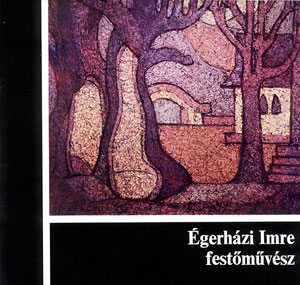The paintings of the painter Imre Égerházi can be seen by the public for years, who are interested in the development of fine art in Debrecen; yet let me tell you here: Imre Égerházi is one of the painters in Debrecen who, through his talent, his demands on himself, his discipline, and his high degree of humanity, rose to be among those who enrich the artistic life of Debrecen with new colors.
His works are now known not only in Debrecen, but he also presented himself in Budapest in 1972; and at several solo exhibitions in Debrecen and in Hajdú cities.
One could see his pictures in Békéscsaba, Szeged, Keszthely, Miskolc, Győr, Szolnok, collective exhibitions, and even participated in the collective exhibitions of the Regional Organization in Lublin and Oradea.
He thinks of the recently deceased painter József Menyhárt as his master.
His hard, disciplined self-education process was best summed up by himself, when he wrote:
“I do it the way my inner self dictates, the way the content wants form. In the painting, I like the edited compositional order, the careful processing, the drawing discipline, and I avoid the loud colors, the opacity that covers a lot of things.”
Many of us have witnessed that this was his way of creation. This now clear, essential form of self-expression is the result of a long, long journey and disciplined work.
Imre Égerházi is not one of the painters who deliberately, boldly, defiantly, or robustly draw attention to themselves. But his style, his world of color, his editing skills still make his pictures individual and attractive. The tool that provides this in his art is the sure highlight with which he can focus the essence on exactly any point in the image.
In recent years, he seems to have developed an airier, cleaner world of colors based on the harmony of related colors. And this is coupled with a moderate, never crowded editing in each case, in which the forms become simpler, symbolic, but always accurately indicate the character and relationship of the objects, the landscape, the person.
Puritan is this style, which can break into substance in this way, as it leaves out all that is superfluous, can and dare to abstract. He does not have a single image on which anything would disturb the harmony of either the colors or the composition.
Another means of this inner, cohesive disciplinary force is virtue, which manifests itself in a representation formed by him in moderation. Let us look at the houses, mountains, trees of mountain landscapes. By placing masterfully simplified and characterized forms, you create dimensions with which you can make up for the artificial approximation-removal of planes.
And here we reach the essence of Imre Égerházi’s art; he can do all this because his confident, disciplined drawing skills, and his always striving for simplification within the boundaries of intelligibility, create a special unity and order in his paintings, with which the displayed message will not be poorer, on the contrary, more expressive, richer.
The artist, who came from a village, also lives in a special environment in his city, apartment building, which also expresses his belonging to our present society. But more importantly, his paintings, the roots of his art, go back to the social medium that we call folk today. And here I am not thinking of the romantic view of the people, but of the real artistic attitude, which also assumes a community of destiny with these social strata.
This is truly understood by those who were also familiar with his earlier images of the lives of peasants in the Olajütő, on the outskirts of the city, or in the simple surroundings of the villages.
These are the themes of Imre Égerházi even today. Only while these confessions appeared in more natural, darker tones in his earlier paintings, today in the complex but always conscious – and perhaps we can say: mature – stage of artistic development the same is as essentially present as the compression and simplification of artistic expression in folk art.
When we see shepherds’ houses hiding in the mountains — indicated by a few simplified lines or spatial forms — or deliberately stretched haystacks sparsely appearing on endless mountain pastures, we never have an idyllic thought, but the centuries-old fate of this social stratum comes to mind.
And this simple picturesque tone, such a high degree of artistic compression, only deepens these feelings in the viewer.
I think the artist is on the right track to continue to develop this artistic mode of representation in pursuit of simplification.
The artist himself put it that he did not like the “all-encompassing obscurity”. I think no one can doubt his optimistic tone and love of life based on seeing the pictures. Because the cloudy sides of life, the critique of society, can also be expressed in such colors.
In addition to striving for modernity in the form of expression that best suits our lives today, the artist must continue to be guided by the artistic principle developed over many years of labor that will surely protect him from breaking away from a society that is the root and say of all art.
Dr. Albert Kurucz
Director, Hungarian Open-Air Museum of Szentendre


